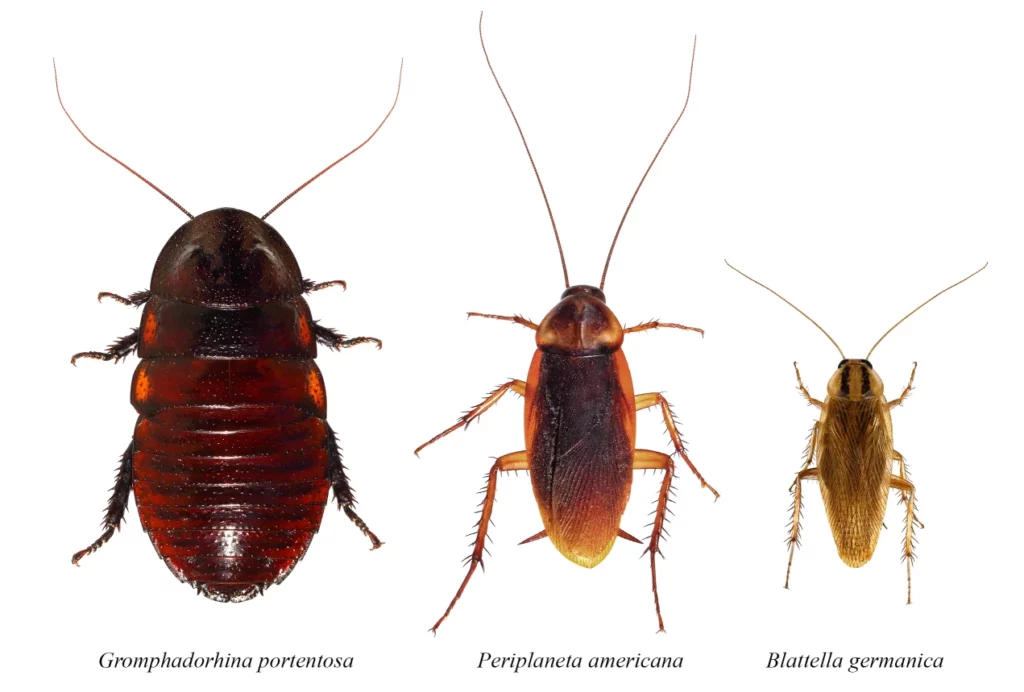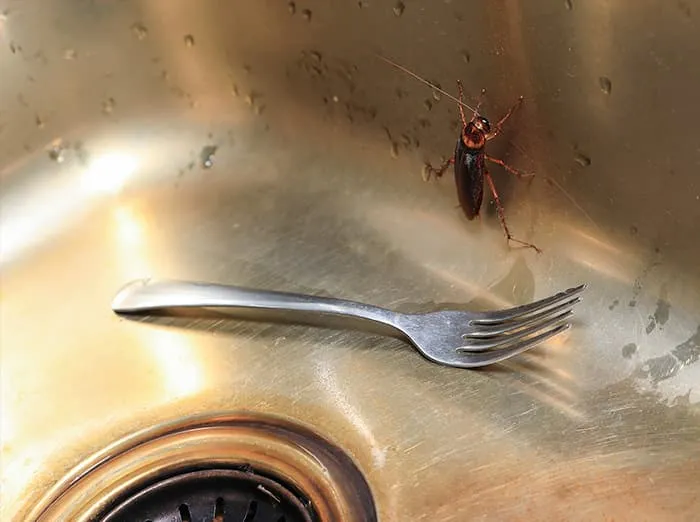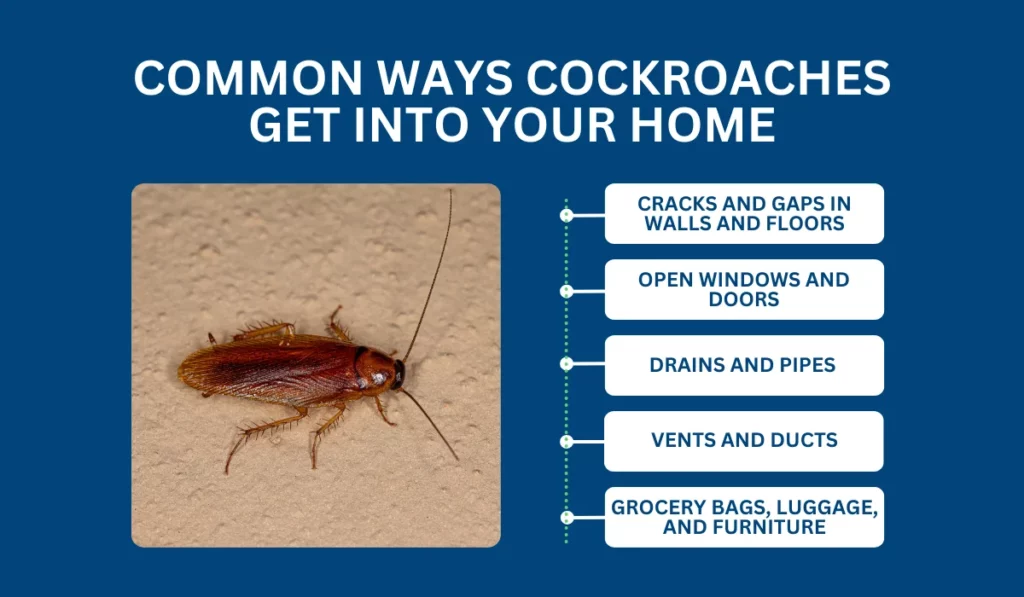Florida’s subtropical climate featuring mild winters, steady warmth, and high humidity enables cockroaches to remain active and reproduce all year long. In Palm Bay, a coastal city along Florida’s eastern shore, these resilient pests can easily invade homes or short-term rentals when unsealed food sources, moisture, or cracks remain unchecked. This service page explains why roaches thrive in Florida, how to detect an infestation, and why employing a professional cockroach exterminator is the most dependable route for restoring a clean, roach-free living or commercial space.
Whether you manage a single-family residence in Palm Bay or operate rental properties near Grant, noting cockroach signs early—and leveraging effective, targeted solutions—helps protect occupants from health risks, contamination, and repeated do-it-yourself attempts that commonly skip concealed egg casings or deeper roach runways behind walls and appliances.
Why Cockroaches Succeed in Florida
Mild Winter Season
In colder regions, subfreezing winters naturally shrink roach activity for months. Florida’s gentle cold season seldom reaches freezing, offering roaches year-round egg-laying and feeding cycles indoors. Climate-controlled interiors (roughly 65–85°F) further remove any seasonal break roaches remaining continuously active.
Abundant Food & Damp Corners
Cockroaches devour nearly any organic material from crumbs on counters to open garbage bins or spilled pet kibble. In coastal Palm Bay, occupant lifestyles might inadvertently provide easy scraps if daily cleaning or leftover disposal lags. Even minor leaks in bathrooms or kitchens supply the moisture they need to thrive.
Rapid Reproduction
A single female roach lays numerous egg cases (oothecae), each containing multiple embryos hatching within weeks. In Florida’s year-round mild climate, a few roaches swiftly transform into large colonies if occupant or property manager detection doesn’t intervene early.
Multiple Cockroach Species
Florida hosts various roach types:
- German Cockroach: Small, reproduces rapidly indoors, often in kitchens and bathrooms.
- American Cockroach (Palmetto Bug): Larger, typically living in sewers or utility tunnels but can invade for food or cooler temps.
- Smoky Brown Cockroach: Prefers outdoor mulch or damp shrubbery, occasionally coming inside.
- Brown-Banded Cockroach: Favors higher, drier spots (like cabinets or electronics).
All can infest indoors if occupant vigilance or staff housekeeping is minimal, especially in a mild-winter climate like Florida’s.

Why a Professional Cockroach Exterminator Is Essential
Detailed Property Inspection
A cockroach exterminator searches damp corners, behind appliances, and in cracks or voids for droppings, egg casings, or roach runways. Identifying roach species German, American, smoky brown, or brown-banded guides suitable strategies focusing on kitchens, bathrooms, or perimeter lines.
Precision Baiting & Spraying
Experts place gel baits or stations along roach “highways” under sinks, behind stoves, or along corners ensuring roaches ingest slow-acting poison shared within nests. Residual insecticides near baseboards or cracks kill roaches crossing treated areas. This synergy surpasses occupant do-it-yourself attempts reliant on random sprays or foggers that rarely reach concealed nest zones.
Insect Growth Regulators (IGRs)
IGRs hamper roach nymph development, preventing them from maturing into reproducing adults. When combined with adulticidal baits, IGRs dismantle the entire roach life cycle. Occupant partial attempts often miss this stage, letting nymphs perpetuate infestations.
Safer Chemical Control
DIY occupant sprays can saturate occupant living zones. Professionals apply regulated insecticides in hidden corners, cracks, or behind cabinets key roach habitats minimizing occupant or pet exposure. Gel baits remain discreetly placed, lethal for roaches yet safe for occupant areas.
Follow-Up & Prevention
Roach eggs can hatch weeks later. Many exterminators schedule occupant re-check calls or do second visits if sightings persist. Occupants receive housekeeping guidance like sealing food, discarding crumbs, or sealing cracks ensuring roaches can’t easily re-infiltrate Florida’s mild winter environment that otherwise supports year-round roach life cycles.
Typical Methods for Cockroach Treatments
- Inspection & Species Determination
- Professionals scrutinize kitchens, bathrooms, or behind appliances for egg casings, droppings, or smear marks.
- Identifying if they’re German, American, or another species clarifies if solutions concentrate on kitchens/bathrooms or perimeter lines first.
- Professionals scrutinize kitchens, bathrooms, or behind appliances for egg casings, droppings, or smear marks.
- Gel Baits & Bait Stations
- Placed where roaches feed—corners, under sinks, or behind stoves—carrying slow-acting poison back to nests.
- Over time, entire roach colonies ingest toxins, collapsing from within.
- Placed where roaches feed—corners, under sinks, or behind stoves—carrying slow-acting poison back to nests.
- Residual Sprays & Dust
- Applied to baseboards, cracks, or behind major appliances to kill roaches crossing treated surfaces.
- Insecticidal dust in wall voids extends lethal coverage for hidden pockets.
- Applied to baseboards, cracks, or behind major appliances to kill roaches crossing treated surfaces.
- Insect Growth Regulators (IGRs)
- Hinder roach nymphs from becoming reproductive adults, slashing future breeding.
- Frequently paired with adulticidal sprays or baits to attack each life stage thoroughly.
- Hinder roach nymphs from becoming reproductive adults, slashing future breeding.
- Exclusion & Minor Repairs
- Occupants or professionals seal foundation cracks, fix door sweeps, or patch holes around utility lines roaches exploit.
- Lowering indoor humidity and fixing leaks denies roaches crucial water resources.
- Occupants or professionals seal foundation cracks, fix door sweeps, or patch holes around utility lines roaches exploit.
- Sanitation & Decluttering
- Occupants store leftover food in sealed containers, discard daily scraps, and keep surfaces crumb-free.
- Reducing cardboard or random storage denies roaches ample nesting corners.
- Occupants store leftover food in sealed containers, discard daily scraps, and keep surfaces crumb-free.
- Follow-Up
- Roach eggs often hatch weeks after occupant sightings fade. Re-check occupant feedback or set sticky traps for new droppings.
- Additional baits or spot treatments finalize occupant reassurance of roach-free living spaces.
- Roach eggs often hatch weeks after occupant sightings fade. Re-check occupant feedback or set sticky traps for new droppings.

Service Area: Palm Bay & Grant
Though roaches adapt to Florida’s mild winters across the state, this page spotlights roach solutions in Palm Bay, plus neighboring Grant—both benefiting from occupant synergy plus professional cockroach treatments. Florida’s gentle cold season never forces roaches dormant, so occupant synergy plus specialized extermination remain crucial for fully removing or preventing roach invasions.
Why Choose Us
Florida-Centric Methods
We integrate recognized cockroach control solutions—gel baits, insect growth regulators, insecticidal dust—focused on Florida’s environment and occupant routines. Occupant synergy (like discarding leftover food, sealing cracks) plus professional extermination ensures adult roaches and upcoming nymphs succumb, surpassing occupant attempts that overlook deeper nests or egg casings.
Thorough Assessments
Before applying chemicals or placing baits, technicians meticulously inspect damp zones, behind appliances, or corners for droppings, smear marks, or oothecae (egg cases). Pinpointing roach species (German vs. American, etc.) clarifies whether to focus primarily on kitchens/bathrooms or perimeter lines.
Precision & Safety
We administer insecticides or dust exactly where roaches congregate—cracks, corners, behind stoves—rather than saturating occupant floors or counters. Gel baits remain strategically placed, ensuring roach ingestion with minimal occupant or pet contact.
Emphasis on Prevention & Sanitation
Removing roaches alone is half the solution. Occupant synergy—like sealing door sweeps, removing clutter, or wiping up crumbs—prevents new roaches from slipping inside. This occupant-professional partnership cements success in Florida’s roach-friendly mild winter climate.
Follow-Up & Extended Assurance
Roach eggs can hatch weeks after occupant sightings vanish. Many exterminators schedule occupant re-check calls or second visits if droppings or sightings reemerge. Adjusting baits, additional dusting, or occupant housekeeping ensures newly hatched nymphs also face lethal exposure, giving occupant peace of mind.

Next Steps
Spotting roaches scurry when switching on lights, discovering pepper-like droppings in cabinets, or finding egg casings behind appliances? Contact us to learn more or schedule your service. Our cockroach treatments for Palm Bay and Grant blend detailed property checks, precisely placed baits or dust, occupant-friendly sealing and sanitation advice, plus vigilant follow-ups comprehensively removing roach colonies while blocking future infiltrations.
Act now to protect occupant or guest health from roach-borne bacteria, keep stored items uncontaminated, and preserve occupant confidence if you manage short-term rentals or commercial facilities. Lean on our Florida-based cockroach exterminator expertise to locate, eliminate, and deter roaches effectively, tackling their mild winter breeding advantage across the Sunshine State to maintain comfortable, pest-free interiors year-round.
Maintaining a Roach-Free Property
After professionals eradicate roaches, occupant diligence prevents their return:
- Proper Food Storage
- Transfer cereals, grains, or pet kibble to sealed plastic or metal bins; discard daily scraps promptly.
- Wipe counters daily, removing crumbs or sticky residues luring roaches.
- Transfer cereals, grains, or pet kibble to sealed plastic or metal bins; discard daily scraps promptly.
- Eliminate Moisture
- Fix leaks under sinks or AC lines; quickly mop standing water.
- Vent damp areas bathrooms or laundry rooms to reduce indoor humidity.
- Fix leaks under sinks or AC lines; quickly mop standing water.
- Limit Clutter
- Organized shelves or labeled bins hamper roaches from nesting behind stacked boxes or papers.
- Clear plastic containers expose droppings or gnaw marks quickly.
- Organized shelves or labeled bins hamper roaches from nesting behind stacked boxes or papers.
- Secure Trash & Recycling
- Keep lids firmly shut, rinsing bins to remove rotting odors.
- Position bins away from exterior walls, reducing direct roach approach routes.
- Keep lids firmly shut, rinsing bins to remove rotting odors.
- Check Pet Feeding
- Feed pets on a schedule, putting bowls away after mealtimes.
- Store large pet food bags off floors in sealed bins, denying easy gnaw targets.
- Feed pets on a schedule, putting bowls away after mealtimes.
- Seal Gaps & Cracks
- Caulk foundation splits, fix door sweeps, or fill utility line holes with steel wool or foam.
- Even dime-sized openings allow roaches inside if occupant or manager oversight declines.
- Caulk foundation splits, fix door sweeps, or fill utility line holes with steel wool or foam.
- Monitor & Re-Treat If Needed
- Should occupant sightings or droppings return, consult an exterminator swiftly before a minor infiltration balloons anew.
- Re-check corners or behind appliances ensures no leftover eggs or fresh roaches re-establish.
- Should occupant sightings or droppings return, consult an exterminator swiftly before a minor infiltration balloons anew.
By integrating occupant housekeeping like sealing food, removing dampness, limiting clutter and specialized cockroach treatments as necessary, Palm Bay and Grant property owners effectively combat Florida’s mild winter advantage for roaches. This synergy halts roach expansions in hidden spots, preserving occupant confidence and cleaner indoor spaces in every season despite the Sunshine State’s roach-friendly climate.
